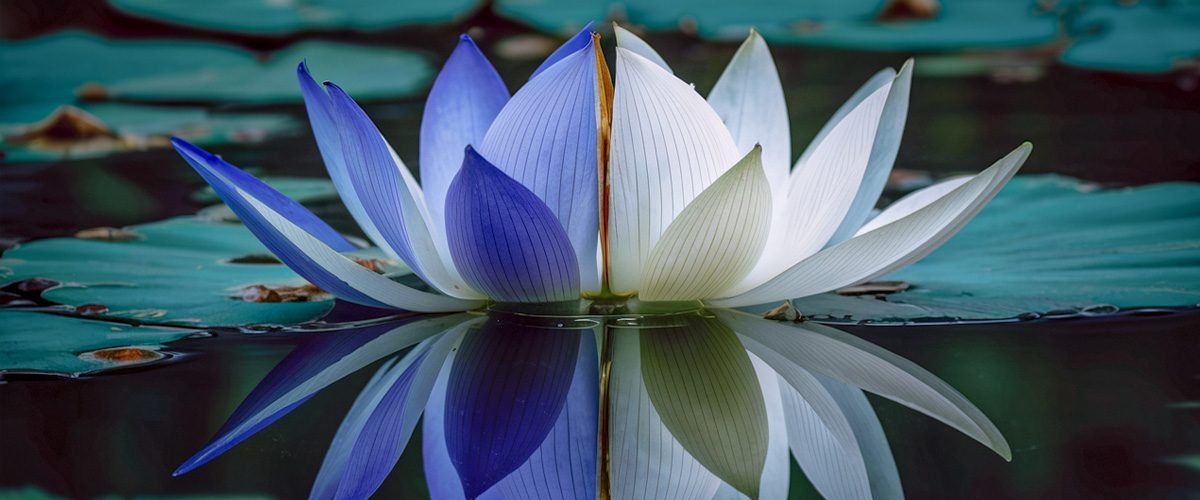White lotus (Nelumbo nucifera) and blue lotus (Nymphaea caerulea) have been used for centuries in various cultures for their medicinal properties and psychoactive effects. Both blue lotus and white lotus have been depicted in ancient history, dating back thousands of years.
Blue lotus & white lotus are nootropics that have been used for their potential health benefits, such as reducing anxiety, promoting relaxation, and improving mood. In addition to their medicinal properties, both plants have also been revered throughout history, symbolizing enlightenment and purity. Let’s explore blue lotus & white lotus, including their history, potential benefits, and scientific research.
Blue Lotus vs. White Lotus

White lotus has gentle consciousness altering effects. It is believed to help promote feelings of peace and relieve physical pain. It is gently warming and euphoric, and it can help enhance meditation and promote the feeling of grounding. Blue lotus is renowned for its relaxation-inducing properties. It’s been used for thousands of years as a natural aphrodisiac, sleep aid, and anxiety reliever.
Both white lotus and blue lotus are known for their unique appearance and symbolism in different cultures. While white lotus is often associated with purity and spiritual enlightenment, blue lotus is typically linked to relaxation and tranquility.
In terms of taste and aroma, white lotus is said to have a sweeter and milder flavor compared to the slightly bitter taste of blue lotus. Overall, both plants offer a range of physical, mental, and spiritual benefits that have been valued for centuries.
The Ancient History of Blue Lotus & White Lotus
The history of blue lotus and white lotus usage dates back thousands of years, with evidence of their use in ancient Egypt, India, and other cultures around the world. Blue lotus and white lotus were believed to have mystical properties that could connect individuals to the spiritual realm and enhance meditation practices.
According to ancient Egyptian mythology, the lotus flower was associated with the sun god Ra and was often depicted in religious art and hieroglyphics. The lotus flower symbolized creation, rebirth, and the sun’s daily journey across the sky. It was a powerful symbol in Egyptian art and religion, representing purity and eternal life. The Egyptians believed blue lotus could provide a spiritual connection to the afterlife and communication with the divine. The blue lotus served as an essential component in religious ceremonies and shamanistic rituals thanks to its psychoactive properties.
In India, the lotus is a symbol of mental purity, often depicted in the hands of deities such as Vishnu and Lakshmi. In fact, the lotus is India’s national flower. The lotus is also a significant symbol in Indian religions and is often used in yoga and meditation practices.
The lotus flower is also a significant symbol in Buddhism, representing spiritual growth and enlightenment. Its ability to rise above the muddy waters and bloom beautifully has made it a powerful metaphor for the human experience of overcoming obstacles, turning poison into medicine. “Just as the pure white lotus flower blooms unsoiled in muddy water, our lives, which are supremely noble, can continue to shine even amid life’s harshest realities,” Buddhist philosopher and SGI founder Daisaku Ikeda firmly asserts.
The widespread use of blue lotus and white lotus in various cultures highlights the universal appeal and significance of these sacred plants throughout history. Both the blue and white lotus have been revered for centuries, serving as powerful symbols of resilience, transformation, and inner peace across different civilizations. Now, further research is being conducted to understand the benefits these plants can bring.
Scientific Research Of Blue & White Lotus
Both white and blue lotus contain alkaloids that are believed to have a range of health benefits, including anti-inflammatory and antioxidant properties. Studies have shown that these alkaloids may also have mild sedative effects, making them popular choices for relaxation and stress relief.
Additionally, blue lotus is known for having aphrodisiac properties, with some cultures using them to enhance libido and sexual performance. Experts attribute blue lotus’ therapeutic powers to not only its alkaloid content, but also other active compounds, including nuciferine, and apomorphine.
Some studies have suggested that compounds found in blue and white lotus may have antioxidant and anti-inflammatory properties, which could make them beneficial for overall health. A significant number of fundamental nutritional compounds, as well as antioxidant and anti-proliferative properties, are present in white lotus, according to one study. Researchers are also exploring white lotus’ potential as a natural remedy for conditions such as insomnia.
As more studies are conducted, we may gain a better understanding of how blue and white lotus can be incorporated into modern medicine to improve health and well-being. While scientific research on their health benefits is ongoing, there is growing interest in reaping the benefits of their potential therapeutic effects.
Experience The Benefits Of Both Blue Lotus & White Lotus

One product that offers both blue and white lotus together as an extract is gaining popularity among those interested in exploring the combined benefits of these two plants. Kream & Faded’s Blue Lotus & White Lotus disposables are packed with 3.5 grams of extract. This new product from Kream & Faded combines the unique properties of each plant to create a potent disposable vape that may enhance relaxation, mood, and overall well-being.
This product is available in 6 unique flavor profiles: Hawaiian Pineapple, Blue Razz Slushy, Cali Peaches, Tangerine Dream, Ape Grapes, and Wat-A-Melon.
Conclusion
The white lotus and the blue lotus are two distinct species of aquatic plants that have been used for various purposes throughout history. White lotus is traditionally associated with purity and spiritual enlightenment, while blue lotus is known for its psychoactive properties and use in ancient rituals.
The comparison between blue lotus & white lotus reveals a fascinating intersection of traditional medicine, recreational usage, and scientific inquiry. The historical significance of these plants, coupled with their potential health benefits, makes them a compelling subject for further research and exploration.




One Response